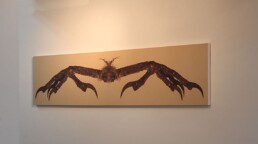VLADIMIR PERIĆ (1962)
Palindromes
photograph on canvas
230 cm x 50 cm (2 pcs)
2009
Palindromes
photograph on canvas
230 cm x 50 cm (2 pcs)
2009
Vladimir Perić draws inspiration for his work mostly in his own environment and often uses discarded objects and fabrics found on flea markets, dumps, streets, and abandoned factories. Respecting the independent life of these objects and materials, as well as the traces of their existence and use over time, Perić transposes them into the art context as ready-mades, or as elements of installations, video works, graphics, photographs, etc. The resulting works have complex meanings, most often characterized by sharp criticism of the social environment, a humorous, lucid but also very personal, emotional language, often associated with the categories of memory – oblivion, childhood, private history.
The term palindrome is derived from two Greek words: palin (back) and dromos (way, direction), which literally means – “what flows backwards”. These are words, sentences and phrases that read the same backward and forward, for example: eye, kayak, nurses run, don’t nod. There are also typographic palindromes, e.g., the word “потоп” (Serbian word for deluge) written in the Cyrillic script, which is an example of perfect symmetry. It is on this principle that Vladimir Perić’s visual (photo) palindromes were created.
In the Palindromes Series, Perić reveals to us several aspects of his pluralistic, but certainly always recognizable, artistic expression. His interest in the culture and nature of the discarded and the displacement of “mere things” from their context and making them unusual through petty interventions is evident through the use and re-articulation of the collected specimens from wildlife. Perić draws our attention to the discarded “surplus materials” from nature, turning them into marks of an artistically built world, based on an almost boyish fascination with the wealth offered by all the specific qualities of different materials from our environment. With the sharpened perceptions of an artist-researcher-collector, Perić recognizes the potential of these objects and materials to transfer us, in an art context, from the everyday and usual into the field of diverse associations and reflections.
© Cultural Centre of Belgrade, October Salon Collection and the artist
Gift Contract: III-5-330/24.8.2016.
Inventory No. 087
Photo: Courtesy of the artist
Selected Bibliography:
48th October Salon, Micro-Narratives. Cultural Centre of Belgrade, 2007
56th October Salon, The Pleasure of Love. Cultural Centre of Belgrade, 2016
David Carson, 2nd Sight, Graphic Design after the End of Print, Universe Publishing, 1997
Stephen Heller, Mirko Ilić, Icons of Graphic Design, Themes & Hudson, 2001 (1st ed.), 2008 (2nd ed.)
Museum of Childhood, Memories Taken Over [author of the text: Slobodan Jovanović] Belgrade: Museum of Applied Art, 2009
Massimiliano Gioni, Natalie Bell, Il Palazzo Enciclopedico = the Encyclopedic Palace: Biennale Arte 2013, Venice, Italy: Marsilio Editori, 2013
Milena Dragićević Šešić, Art and the Culture of Resistance, Belgrade: CLIO, 2018
ABOUT THE AUTHOR:
Vladimir Perić (1962, Zemun, Serbia) is a multimedia artist, present on the local and international scene for over thirty years. For the first ten years (1986–1996), he appeared under the pseudonym Talent, then for the next ten years (1996–2006) worked and exhibited as the founder and member of the Talent Factory Group, after which he started the Museum of Childhood – conceived as another ten-year-long phase, but continued as a longer-term art-museum project. After his Talent Factory phase, the author has exhibited under his own name and surname and, since 2013, occasionally in tandem with Milica Perić, art historian, who joined him in the Museum of Childhood Project.
Perić has had more than eighty solo exhibitions and participated in over two hundred group exhibitions. He received the Politika Award from the Vladislav Ribnikar Fund for the best exhibition in 2005 (Made in Yu, Haos Gallery, Belgrade), and in 2013, together with Miloš Tomić, represented Serbia at the National Pavilion, 55th Venice Biennale. More information at http://www.vladimirperic.rs/

